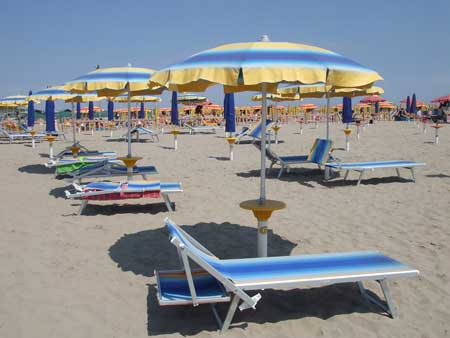About Sottomarina
Sottomarina is a modern beach resort at the southern end of the Venetian lagoon in the north-east Italian region called the Veneto. It is technically an island, between the Adriatic Sea, the lagoon and the mouth of the Brenta river. The town is connected by bridges to the historic fishing port of Chioggia, on a smaller island in the lagoon, and it is sometimes called Sottomarina di Chioggia. Sottomarina isn’t a particularly interesting town in its own right, but Chioggia has a long history, picturesque scenery, art and churches, so the two combine to make a fairly complete holiday destination. Venice is nearby which allows for interesting day trips, or even a varied two-centre holiday. The resort of Sottomarina is popular mostly with Italians and with German-speakers (as you will spot from tourist signs).
Find and book hotels. With location maps and guest reviews.
Sottomarina’s beach runs along the Adriatic shore. It is long and sandy and lined with private bathing establishments, as is normal in Italy. They are interspersed with little cafes and snack bars on the beach, so you don’t need to leave the sands at all. I visited in May, when the businesses were just beginning to open for summer. If you visit before the traditional Italian holiday period of July-August you will find more space and better-value accommodation. Many sunbathers had chosen to eschew the comforts of sunbeds, showers and changing-cabins and had simply brought their own towels to lie on. There is an official stretch of free beach (spiaggia libera) towards the white breakwater at the north end of the beach. Alternatively you could opt for the sands at the water’s edge, outside the demarcated ‘private’ areas. Sometimes in Italy you’ll be prevented from doing this, but in Sottomarina in May it seemed accepted.
> More about Italian beach culture
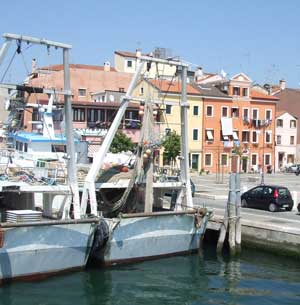
At the back of the beach are rows of bathing huts, more beach restaurants and the entrance gates to the private beaches. There isn’t really a sea-front promenade to stroll along: the road is busy and separated from the sea by the buildings, fences and car parks of the beach establishments. On the far side of the road, the hotels begin. There are lots of low-rise hotel and holiday apartment buildings which aren’t hideous but aren’t particularly attractive either. Small leafier avenues just inland are also lined with places to stay for Sottomarina’s summer visitors.
For a pleasant stroll by the sea and some good views, head to the long breakwater which extends between the beach and the mouth of the lagoon. It is a narrow and popular promenade, passing by some curious wooden chalets on stilts which are used for fishing purposes. Boats pass by, along the channel which connects the lagoon with the open sea. Looking back you enjoy a panorama which extends from the long beach to the low Euganean Hills behind the lagoon. If you walk back towards the lagoon, towards the historic fortress which guards Chioggia, the Forte San Felice, you pass the workings for Venice’s controversial sea defence system, MOSE, which involves ‘gates’ being installed in each of the three lagoon entrances.
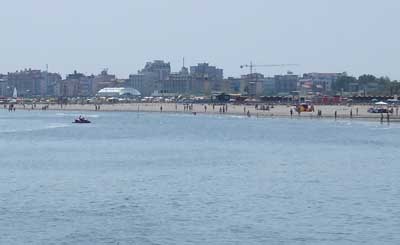
Apart from the beach itself, with its gaily-coloured beach umbrellas and sunbeds, the most appealing part of Sottomarina is the oldest part of town. This lies on the lagoon side of the island-town, facing over the water to Chioggia. Behind the old sea-wall, which is still visible and curiously out-of-place, are clusters of older buildings around tiny squares and alleys. These are shabby but bustling with life, still inhabited by the fishermen whose boats are moored at the quay opposite. You can also find a few traditional shops and restaurants (trattorie) in this part of town. The lagoon shore is very reminiscent of Pellestrina, the next island along which also sits between the lagoon and the sea.
There are a couple of public parks in Sottomarina, if you are looking for some greenery or a play area for children. One is on Viale Umbria, near the bus station, and the other is on the Isola dell’Unione, the island between Sottomarina and Chioggia. Along the sea-front there are various little holiday-type attractions for children and adults, including a mini-golf course.
Sottomarina’s tourist information office is on the seafront road, the Lungomare Adriatico, near the junction with Viale Veneto which heads towards Chioggia. The office closes for a couple of hours in the middle of the day.
When you have wandered around Sottomarina, head over the bridge to historic Chioggia. There are more traditional tourist sights here, including some interesting churches, an art gallery and a picturesque fishmarket. Although it is still a notable fishing port, it has a much less ‘seaside’ feel to it and as you sit at a cafe’s outdoor tables watching locals cycling and shopping it makes a real change from Sottomarina.
> Chioggia in detail
Things to do in and around Sottomarina
There are several wildlife oases in the area which can be visited. Various excursions to these and other local sights, such as the northern lagoon islands (Torcello, Burano and Murano) are organised in the summer holiday season. We’ve added a useful link to our right-hand panel, but your best bet is to visit the tourist information office to see what is on during your stay.
Sottomarina and Chioggia are trying to involve tourists in the towns’ other main business: fishing. If you walk along the lagoon shore or catch a boat towards Pellestrina, you will see some of the fascinating huts built above the water. Various tours can be organised of the fishing grounds and waterways used by the local fisherman. Again, ask at the tourist information office for advice.
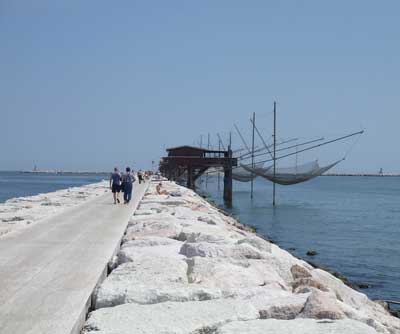
If you fancy something more active than sunbathing, exploring and swimming, you could hire bicycles. Cycling is a good and popular way to get around these two interlinked towns and the nearby countryside, and the enterprising visitor can catch the ferry towards Pellestrina and the Lido and cycle along the margins of the lagoon and sea. In Sottomarina there are cycle paths laid out along some of the roads.
If you have a car, there are quite a few interesting places to explore in the area around Sottomarina. Even if you are relying on public transport, there are still several excellent possibilities for day trips. Venice is the most obvious destination, along with the other lagoon islands, but there is also a direct bus link to Padua, where there is a great deal to see.
Sottomarina travel
The nearest airport for Sottomarina is Venice Marco Polo Airport. From July to September there is a shuttle bus between the airport and Sottomarina, which is free to tourists who’ve booked one of a range of hotels or campsites in the town. At the time of writing the bus runs twice a day from Friday to Monday, but check with your hotel for the latest information. Otherwise, from Marco Polo Airport or from Ryanair’s nearest airport, Venice Treviso, you should catch a bus to Venice (see our airports pages for more information) and then change to the Sottomarina bus at Piazzale Roma, Venice’s bus terminus.
Chioggia has a railway station which is connected to Rovigo by slow regional trains. If you are coming from Rovigo, or a distant spot on the Italian rail network, this is a practical option, but Sottomarina’s most efficient connections with neighbouring towns are by bus. As well as services to Venice (see below) there is also a bus service to Padua (Padova) which runs approximately every half-hour. It’s run by a firm called SITA. Sottomarina’s bus station is a few minutes’ walk from the sea, at Piazza Europa.
There are urban bus routes within Chioggia and Sottomarina, making it easy to get around when you’re tired of walking. These are operated by ACTV.
Transport to Venice
Sottomarina is connected to Venice in three different ways. There is a regular bus service which runs past Chioggia and along the mainland shore of the lagoon. This bus, the 80E, is run by ACTV and takes approximately an hour and twenty minutes. It’s a bendy bus and reasonably comfortable, though the speed of the journey depends on traffic. There are some interesting views of the southern end of the lagoon. This is probably the most efficient way to reach Venice. The most scenic route though, is to head over to Chioggia on foot or by local bus, and then take the slow number 11 service. This is a combined ferry and bus route which runs along the rim of the Venetian lagoon, along the island of Pellestrina and finishes at the Lido, which is a short boat-ride from central Venice. Thirdly, in the summer months there are direct ferry services from Sottomarina to Venice especially planned for holiday-makers on excursions. The ferries leave from the Isola dell’Unione.
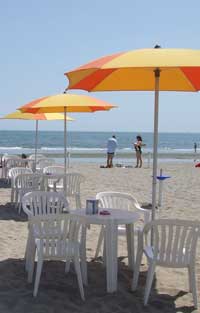
Sottomarina accommodation
Most of the Sottomarina hotels are very standard Italian seaside hotels, boxy in appearance and notable chiefly for their proximity to the beach. The four-star Best Western Hotel Bristol is a decent choice; it has a central seaside location, a private stretch of beach and a swimming pool. Hotel Le Tegnùe (named after the local underwater reef habitats) is another four-star hotel on the sea-front road and is a slightly smarter option. It also has a pool.
> Book a hotel in Sottomarina
On this site
Travel to Chioggia from Venice
Useful external links
Raffaello Navigazione – lagoon tours and ferries to Venice
Veneto destinations
- Veneto region
- Abano Terme
- Asolo
- Bassano del Grappa
- Brenta Canal
- Caorle
- Castelfranco Veneto
- Chioggia
- Cittadella
- Concordia Sagittaria
- Conegliano
- Cortina d’Ampezzo
- Lido di Jesolo
- Malcesine
- Marostica
- Monselice
- Montegrotto Terme
- Padua
- Portogruaro
- Rovigo
- Sottomarina
- Treviso
- Venetian Lagoon
- Venice
- Verona
- Vicenza
- Veneto art & architecture itinerary
- Veneto villas – Vicenza: La Rotonda & Villa Valmarana ai Nani
- Veneto villas – Villa Pisani & Villa Foscarini Rossi, Strà
- Venice Airport
- Treviso Airport
